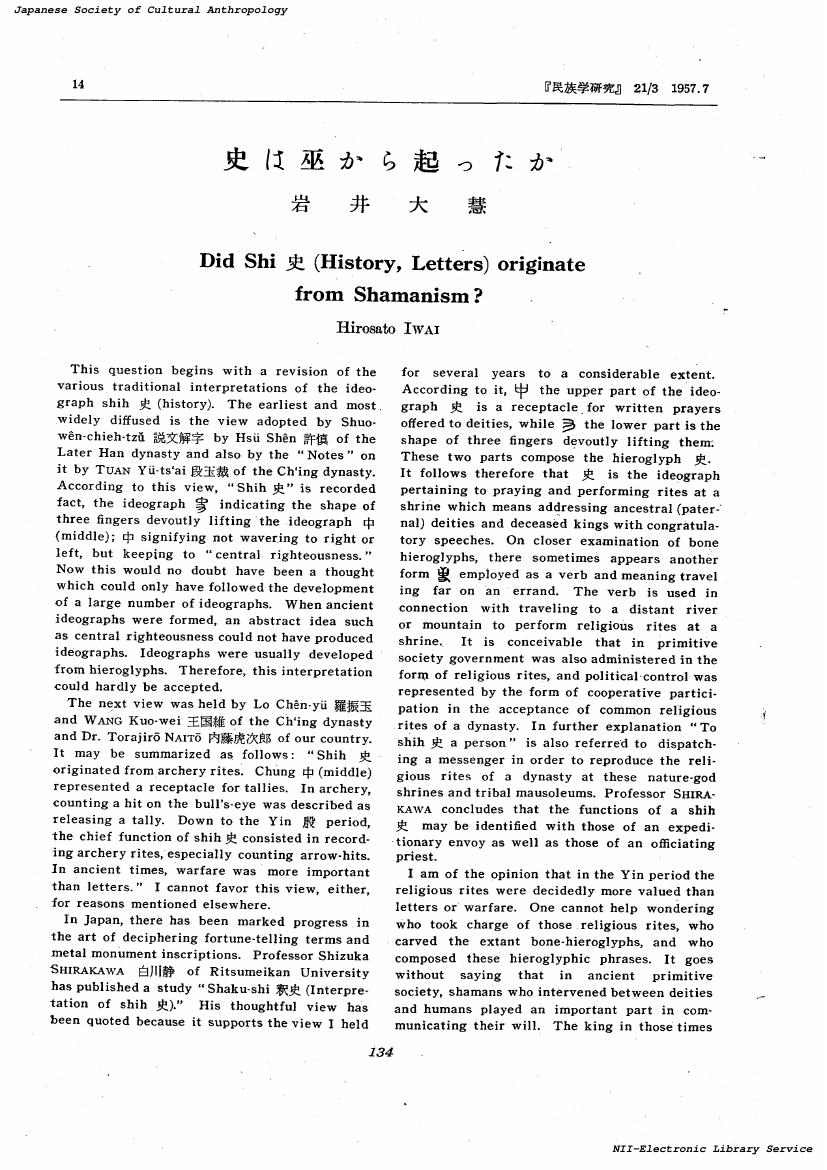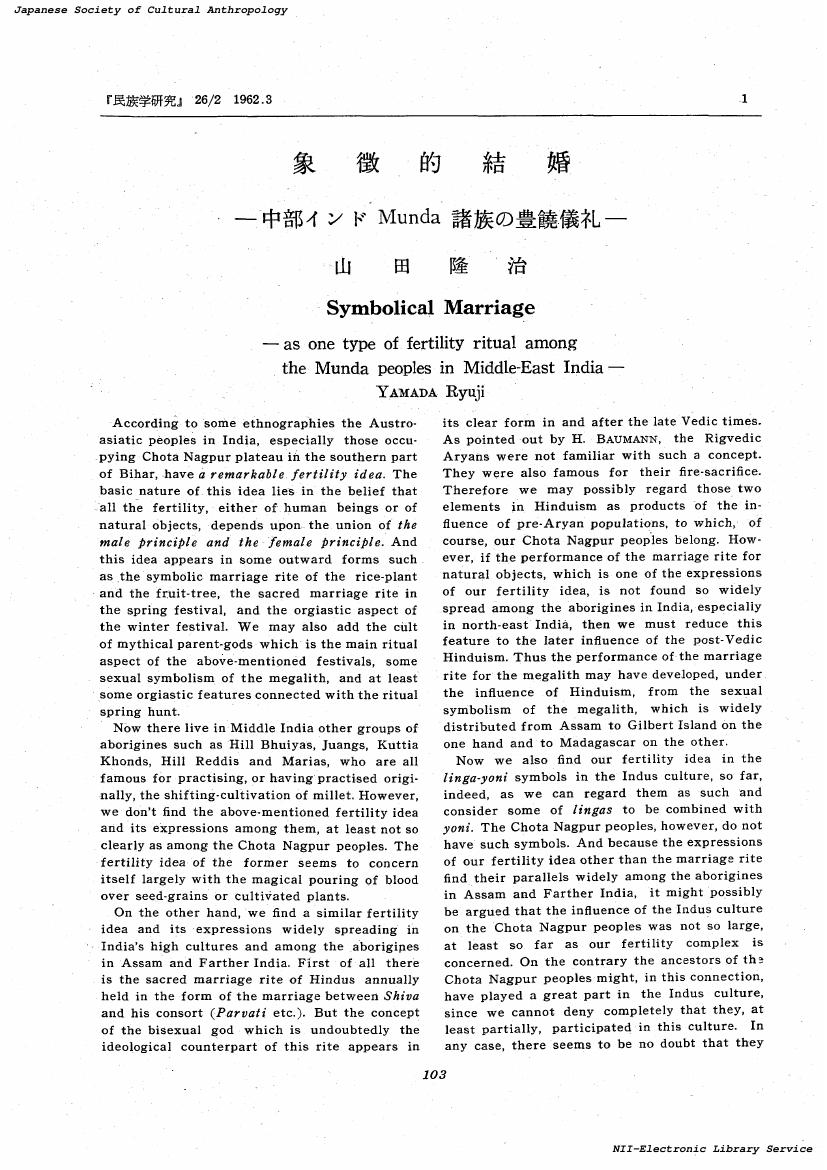- 著者
- 池谷 和信
- 出版者
- 日本文化人類学会
- 雑誌
- 民族學研究 (ISSN:00215023)
- 巻号頁・発行日
- vol.64, no.2, pp.199-222, 1999-09-30
- 被引用文献数
- 1
毛皮は, かつて"柔らかい宝石"と呼ばれ, 西ヨーロッパや中国において上流階級のステータス・シンボルを示した。本稿では, 世界システム論の視点から, 世界の毛皮をめぐる中核と周辺の変化の動態を把握する枠組を提示したあとに, カラハリ砂漠における毛皮交易の盛衰を通して狩猟民の社会変化を把握することを目的とする。16世紀以降の毛皮交易史をみていくと, 世界には西ヨーロッパ, 中国, 日本, アメリカという4つの中核が存在してきたこと, 北アメリカ, シベリア, 中国東北部に加えて南部アフリカも毛皮交易の発達がみられた地域であること, 1930年頃にはサン, ピグミー, イヌイット, オロチョンなどの世界の周辺に暮らしていた人々が, 共通に世界経済システムの周辺に組み込まれていたことが明らかになった。また, カラハリ砂漠において毛皮交易の盛衰をみていくと, サンのなかには毛皮の運搬や猟法の変化などのように直接的影響を受けていた人々とカラハリとの毛皮の交換を通して無意識のうちに世界システムに巻き込まれていった人々という2つの対応がみられた。とりわけ1930年代には, サンがカラハリに従属する関係がみられたが, 毛皮税の支払いがなくなると, サンの自立性が高まっていった。しかし, この地域での毛皮交易の永続性は短く, 1950年代におけるサンによる農場への労働力移動という側面が, 社会変容に大きな影響を与えていた。以上をふまえて, 人類学における世界システム論の視点を用いた研究では, 世界的に毛皮の流通が世界の周辺にまで浸透していた点や現存している人々から聞き取り調査の可能な点から, 1930年代の毛皮交易による社会変化の復元に焦点を置くことで新しい成果が生まれると考えられる。
- 著者
- 大林 太良
- 出版者
- 日本文化人類学会
- 雑誌
- 民族學研究 (ISSN:00215023)
- 巻号頁・発行日
- vol.39, no.4, 1975-03-31
- 著者
- 佐々木 重洋
- 出版者
- 日本文化人類学会
- 雑誌
- 民族學研究 (ISSN:00215023)
- 巻号頁・発行日
- vol.61, no.1, pp.1-27, 1996-06-30
「クロス・リヴァー地方」のエジャガム社会では,死に「善悪」判断がくだされ,それに応じて異なる埋葬がおこなわれる。その際,特定の身体的症状を呈する死およびブッシュや川などの特定の空間における死が「悪い死」と判断され,遺体は舌を切られたうえ,集落の外に設けられた「邪悪な森(悪いブッシュ)」にうつぶせに埋葬される。本稿は,この慣行内容に関する記述をおこない,「悪い死」を決定する判断基準およびその論理を分析するとともに,このような慣行が社会において果たす役割について考察する。また,死の「善悪」判断とそれに応じた埋葬慣行が操作的になされていることを認めた上で,そのような意図を必要とさせる社会的背景にも注目する。とくに,個人の極端な成功や突出をめぐる相矛盾した価値観が併存するエジャガム社会において,「悪い死」概念を支える論理,いわば災因関する知の体系が自己抑制を社会的に達成していることを指摘する。
- 著者
- 真島 一郎
- 出版者
- 日本文化人類学会
- 雑誌
- 民族學研究 (ISSN:00215023)
- 巻号頁・発行日
- vol.62, no.3, pp.419-424, 1997-12-30
1 0 0 0 OA アイヌ語のイナウの語の由来に関する小考 : ウイルタ語のillauの語原にふれて
- 著者
- 池上 二良
- 出版者
- 日本文化人類学会
- 雑誌
- 民族學研究 (ISSN:24240508)
- 巻号頁・発行日
- vol.44, no.4, pp.393-402, 1980-03-31 (Released:2018-03-27)
The Ainu word inaw means 'a ritual offering in the form of a wooden staff with attached wood shavings'. It is similar to the Gilyak words inau and nau, the Uilta illau and the Orochi ilau. They are assumed to be originally the same word. The Uilta word illau (=illaun-) is probably derived from *ilawun. This form is composed of a verb-stem *ila- and a substantive-forming suffix *-wun which means 'instrument, etc.'. It seems to have changed into illau (n-) by the loss of *w and the compensatory doubling of *l. The Orochi word ilau came also from an earlier form *ilawun, in which the *w and *n were dropped. The suffix *-wun goes back to the proto-form *-pun which survives in Uilta -pu (n-). Consequently, the Uilta word illau (n-) derived from *ilawun containing *-wun seems to be a loan-word, and to have been borrowed probably from Orochi or another Tungus language closely related to Orochi. On the basis of the meanings of the Manchu verb-stem ila- and its derivatives, we assume that *ila- accompanying *-wun means 'a stick which puts forth flowers, or a stick which men shave'. It may be assumed that the Ainu word inaw came from the Tungus word ilau. The Ainu language borrowed this Tungus word, but the l-sound was replaced by n, because Ainu has an n-sound but not l. If a Tungus dialect, such as Orochi or Uilta has borrowed an Ainu word like inaw, it would have preserved the n instead of replacing it with l, because these dialects have n as well. The Gilyak words inau and nau are probably also loan-words which orginated from the Tungus word ilau.
1 0 0 0 OA 秘伝とハウツーのあいだ : フィールドワーク技術論の可能性についての覚え書き
- 著者
- 佐藤 郁哉
- 出版者
- 日本文化人類学会
- 雑誌
- 民族學研究 (ISSN:24240508)
- 巻号頁・発行日
- vol.58, no.3, pp.272-276, 1993-12-30 (Released:2018-03-27)
1 0 0 0 OA マルのヤフェット理論とスターリンの批判後のソ連言語學界
- 著者
- 村山 七郎
- 出版者
- 日本文化人類学会
- 雑誌
- 民族學研究 (ISSN:24240508)
- 巻号頁・発行日
- vol.16, no.2, pp.137-143, 1951 (Released:2018-03-27)
The Yaphetic theory of N. Marr and his followers had been propagated during last twenty years as the genuine Marxist theory of language. In June 1950, Stalin published his famous article, "On Marxism in Linguistics, " and gave Marr's theory a decisive blow. Being no linguist, he had to rely on critics of Marr, principally Prof. Chikobava at Tiflis University. Although his criticism created a sensation in the USSR, we can find little other than propositions usually found in text-books of comparative linguistics. In recent years the Yaphetic theory has met the strong opposition of the Moscow linguists headed by Academician Vinogradov. This opposition was based on traditional, i. e. comparative-historical linguistics. After Stalin's criticism, the Institute of Language and Thought, the citadel of Yaphetic theory, was dissolved, and in July 1950, a new Institute of Linguistics was established. Vinogradov, who had been accused by Marrists of being "reactionary, " was elected director. A review of the work of this new Institute in the last months indicates clearly that the currently-prevalent trend in Soviet linguistics is based on the comparative-historical method. The present day Soviet linguists emphasize historicism.
1 0 0 0 OA 越後のマタギ
- 著者
- 椿 宏治
- 出版者
- 日本文化人類学会
- 雑誌
- 民族學研究 (ISSN:24240508)
- 巻号頁・発行日
- vol.32, no.4, pp.303-317, 1968-03-31 (Released:2018-03-27)
Matagj is the traditional hunters group in the North-East region of Japan. The original home of Matagi is said to be either Akita or Dewa District. They live in a moutainous region, practise special rituals and observe certain taboos and hunting traits. In the past they wandered seeking game from mountain forest to mountain forest all over the eastern half of Japan. As professional hunters they hunted almost every kind of wild animal and bird in the mountains, sometimes even fishing in the rivulets. But their best game was bear, and the next was antelope. As people of the mountain they worshipped the mountain god (Yamanokami) and observed some rituals and kept taboos when they went hunting. While hunting, ordinary daily words were strictly prohibited and special terms (Yamakotoba; mountain words) were used. Etigo, a distrct neighboring Dewa, in about 300 kms from the center of Matagi country. The Etigo Matagi are not professionals, but have special hunting rituals, taboos and other customs. Now they hunt only bears, but formerly sometimes antelopes. No other game was traditionaly hunted. Recently the observation of old traditional rituals, taboos and hunting traits has gradually gone out of fashion and only a few have survived. From my recent research, I was able to reconstruct the total process of the old rituals and determind two rules concerning their preservation. 1) the more dangerous the hunting course, the more traditional the hunting methods. 2) the remoter the Matagi village, the better preserved the old traditions. I could find no direct relations between the Matagi rituals and the bear festival of the Ainos (Iomante). Behind the habit of using special words while hunting, there may be something common in the way of thinking between the Matagi and the peoples of Siberia.
1 0 0 0 OA 史は巫から起ったか
- 著者
- 岩井 大慧
- 出版者
- 日本文化人類学会
- 雑誌
- 民族學研究 (ISSN:24240508)
- 巻号頁・発行日
- vol.21, no.3, pp.134-140, 1957-08-25 (Released:2018-03-27)
1 0 0 0 OA 越境するラスタファリ運動 : タンザニア都市における社会宗教運動の展開
- 著者
- 石井 美保
- 出版者
- 日本文化人類学会
- 雑誌
- 民族學研究 (ISSN:24240508)
- 巻号頁・発行日
- vol.63, no.3, pp.259-282, 1998-12-30 (Released:2018-03-27)
奴隷貿易によって「新世界」へと離散した黒人たちは奴隷制時代から現代に至るまで, 多くの社会宗教運動を生みだしてきた。なかでも1930年カリブ海地域のジャマイカで誕生したラスタファリ運動は, パン・アフリカニズムの思潮を受け継ぐとともに都市貧困層の連帯を支える文化運動として世界的な発展を遂げている。本稿は, 東アフリカのタンザニアにおけるラスタファリ運動の展開について論ずる。地方出身の出稼ぎ民の流入とともに人口増加と民族混交の進むタンザニア都市において, ラスタファリ運動は若年貧困層を中心に新たな路上文化として発展している。また運動は民族を越えた共同体を形成し, NGO団体として農場建設運動を推進している。さらにこの運動はカリブ海地域や欧米からアフリカに移住してきた離散黒人とタンザニア人の双方によって担われ, 運動の継承と解釈をめぐって相互の交流と差異化が生まれている。本稿はタンザニアにおけるラスタファリ運動の展開を検討することにより, 都市貧困層の社会的実践のもつ多様な可能性を示し, また現代アフリカにおける市井のパン・アフリカニズムの実状と問題を検討する。
1 0 0 0 OA 臓器移植・贈与理論・自己自身にとって他者化する自己(<特集>先端技術と/の人類学)
- 著者
- 出口 顯
- 出版者
- 日本文化人類学会
- 雑誌
- 民族學研究 (ISSN:24240508)
- 巻号頁・発行日
- vol.66, no.4, pp.439-459, 2002-03-30 (Released:2018-03-27)
臓器移植は生命の贈り物といわれるが、いかなる意味で「贈り物」なのかを考えたい。少なくともそれはモースが考察の対象とした「アルカイック」な贈与とは異なることがアメリカでの臓器移植を積年研究してきたフォックスとスウェイジー批判で示される。さらにこの問題を考えるとき、人類学で培われた贈与理論がどの程度有効なのかを、ワイナーとゴドリエからマリリン・ストラザーンへと、比較的新しい理論からそれ以前の理論へいわば脱構築しながら検討する。ゴドリエの理論は「贈与」されるのが生命それ自体であり、臓器はその表象であることを明らかにするのに有効であるが、西洋近代の人格概念を前提にしているため、ドナーと自らの二つの人格あるいは生命が併存する共同体として自己を受けとめるレシピアントの体験を据えきれない欠点がある。むしろ、ストラザーンのメラネシアの人格観のモデルが、そうした体験をうまく説明できるものとなっている。しかしストラザーンのモデルでは、柄谷行人の言う「他者」が不在であり、また柄谷にしてもストラザーンにしても「自己」が「他者」化する可能性は全く考慮されていない。自己自身にとって他者となる自己という主題を考察してきたのは、さらに時間を遡るが、レヴィ=ストロースである。自己の内部に出現する他者や侵入者というその視点から、臓器移植は概して外部からの侵入者の物語であることがわかるが、それを内部の侵入者としてとらえる余地はないか最後に検討を試みてみる。
1 0 0 0 OA 伝統的治療儀礼の患者像とその変化 : スリランカ南部の祓霊儀礼の現代性
- 著者
- 上田 紀行
- 出版者
- 日本文化人類学会
- 雑誌
- 民族學研究 (ISSN:24240508)
- 巻号頁・発行日
- vol.55, no.3, pp.269-295, 1990-12-30 (Released:2018-03-27)
スリランカ南部農漁村地帯の祓礼儀霊の減少は, 一般に近代科学の後進的な呪術に対する勝利という自明性のもとに語られる。しかし, 本論文における, 儀礼の扱う患者像と, その減少の特異性の詳細な検討の結果は, そのステレオタイプを否定する。従来ひとまとめに考えられていた祓霊の患者像は, 儀礼の種類によってまったく異なっていることが24のケースの分析から明らかにされる。すなわち急激なストレスによる解離的なヒステリー性症状を病む患者に対する儀礼と, より症状が身体的である患者に対する儀礼のうち減少しているのは後者であり, 前者の比率が急激に高まっているのである。それは長期的に見れば, 西洋医療の浸透によって身体症状を病む患者が祓霊を行なわなくなったことと関連する。しかし, 最近20年間の儀礼の増減からは, 社会的な不平等が強まり, 村の民衆が強い剥奪感を抱く時期に, 解離型の患者が増加するという傾向を見てとれる。つまり, 伝統的治療儀礼は近代化, 急激な資本主義化による村落共同体の解体, 個の疎外といった現代的状況とこそ深く関わっているのである。
1 0 0 0 OA 日本語親族名称語源考
- 著者
- 川本 崇雄
- 出版者
- 日本文化人類学会
- 雑誌
- 民族學研究 (ISSN:24240508)
- 巻号頁・発行日
- vol.41, no.1, pp.57-74, 1976-06-30 (Released:2018-03-27)
This is one of the attempts to present lexical evidence relating Japanese to the Austronesian languages. Most of the Old Japanese (OJp.) kinship terms are, according to the author, derivative from or cognate with Proto-Austronesian (PAN) or its branches Proto-Indonesian (PIN), Proto-Eastern-Oceanic (PEO), and Proto-Polynesian (PPN), as follows : 1.1. OJp. titi, ti 'father, forefather' <*tu-i (*i=suffix forming the independent form of a noun) : PAN tuqa 'old ; father, forefather.' 1.2. OJp. fafa, fa 'mother' ; cf. ModJp. paipai 'mother's breast' : PAN bayi 'mother ; motherly. ' 2.1. OJp. omo 'mother,' the nasal form (n. f.) of OJp. ofo- 'grand-' : Malay (Ml.) empuan 'woman', probably : PAN e(m)pu 'grandmother, grandfather.' 2.2. OJp. ofodi 'grandfather' <*ofo-ti, ofoba 'grandmother' <dfolfa : PAN e (m)pu 'grandmother, grandfather.' 3.1. OJp. kaso 'father': Ml. ketua 'elder,' Maori katua 'full-grown, adult, of animals' : PAN ka- prefix, PAN tuqa 'old ; father.' 3.2. OJp. iro- 'maternal' ; cf. OJp. ira 'descent from a royal family' : the Banks Island languages iro 'personal article feminine,' ira 'personal article plural.' 4.1. ModJp, toto 'father' <*tu (reduplicated) : PAN tuqa 'father.' 4.2. ModJp. kaka 'mother': PAN kaka 'elder sister.' Cf. Fiji (Fi.) tua-ha 'elder brother, elder sister': PAN tuqa-kaka. 5.1. OJp. oya 'parent' <*oyo-a (-a=noun-forming suf.) <*moηtua : Ml. me-nua-kan 'let s. t. grow older, riper' <*meη-tua-han (*meη-=verbalizing pref., *.-kan transitive suf.) 5.2. OJp. ko 'child, son, ago 'dear child, dearest,': PAN a (η)ken 'mine' ; cf. Dayak aken 'nephew, niece.' 5.3. OJp. mago 'grandchild' : PAN makempu 'grandchild.' 6.1' OJp. mama 'step-', n. f. of *fafaru : PIN balu 'step-.' 6.2. OJp. mama 'foster mother', ModJp. child 1. mama 'food' : PAN mamaq: PPN mama 'food which, after being chewed, is to be fed to a baby.' 7.1. OJp. ani 'elder brother' : PAN Rani 'manly.' 7.2. OJp. ane 'elder sister' <*anne <*manne <*mamine, n. f. of *fafi,ee : PlN babi 'womanly,' PAN binay 'woman' : PPN fafine 'woman.' 8.1. OJp. ye 'elder brother of a man, elder sister of a woman' <*yd <*ntua : Ml. tua 'elder of the two' : PEO tuaka 'elder brother of a man, elder sister of a woman.' 8.2. OJp. oto 'younger brother of a man, younger sister of a woman' <*uto by vowel alternation (v. a.) <*uta : PAN uda 'young' ; Ml. muda 'younger of the two' <m-uda. 9. 1. OJp. se 'brother of a woman, husband' <*so : PAN tuqa : PEO tua 'father, man.' Cf. OJp. se, so 'the back ; remoter side' : PEO tua 'the back ; remoter side.' 9.2. OJp. imo 'sister of a man ; wife,' n. f. of *ifo : PAN ibu 'mother.' 10. OJp. tuma 'spouse' : PAN teman 'companion' 11.1. OJp. wo 'man, husband' <*mpu : PAN pu 'gentleman' 11.2. OJp. me 'woman, wife' <?*mi, n. f. *fi : PAN binay 'woman' 12.1. OJp. wotoko 'man, husband,' woto <*mputo 'young, marriageable,' v. a. of *mputa ; -ko 'man' : PAN buza 'young, marriageable, 12.2. OJp. wonna, womina 'girl' <mpomina : PPN fafine 'woman' 13.1. OJp. tozi 'mistress' <*tunsi: PAN tu(n) zuk : PPN tusi 'to bewitch s. o. by pointing at him ; sorcery, priest' 13.2. OJp. nusi 'master, minister,' n. f. of *tusi : PAN tu (n)zuk : PPN(View PDF for the rest of the abstract.)
1 0 0 0 OA アイヌとトーテム的遺風 : 特にレプンカムイシロシとキムンカムイシロシに就て
- 著者
- 河野 廣道
- 出版者
- 日本文化人類学会
- 雑誌
- 民族學研究 (ISSN:24240508)
- 巻号頁・発行日
- vol.2, no.1, pp.45-53, 1936-01-01 (Released:2018-03-27)
1 0 0 0 OA 日本の昔話にみられる物語の文法(narrative grammar)を求めて
- 著者
- 古岩井 香予
- 出版者
- 日本文化人類学会
- 雑誌
- 民族學研究 (ISSN:24240508)
- 巻号頁・発行日
- vol.40, no.2, pp.127-138, 1975-09-30 (Released:2018-03-27)
1 0 0 0 OA 妻を引き抜く方法 : 規約的必然としての「呪術」的因果関係(<特集>呪術再考)
- 著者
- 浜本 満
- 出版者
- 日本文化人類学会
- 雑誌
- 民族學研究 (ISSN:24240508)
- 巻号頁・発行日
- vol.62, no.3, pp.360-373, 1997-12-30 (Released:2018-03-27)
人類学者は, さまざまな実践をまちまちな理由に基づいて「呪術」に分類しているように見える。呪術というカテゴリーがなんらかの統一された研究対象を規定しているとは考えないほうがよいのかもしれない。本論は, 行為とその結果の結び付きについての知識の特殊な性格が, その知識を前提とした慣行を「呪術的」に見せているような場合について検討する。ケニア海岸地方のドゥルマにおいては, 水甕を夫が動かすことが, 妻に死をもたらす行為であるとして禁じられている。ここでの, 水甕を動かすことと妻の死との因果的な結び付きについての知識を構成している諸要素の関係を明らかにすることが本論の具体的な課題である。この知識の内部では, 妻と彼女が所属する屋敷との関係についての「隠喩的」な語り口の内部での必然性と, 水甕を動かすことと土器の壷をめぐるさまざまな慣行とのあいだの相対的有縁性が, 恣意的な規約性によって結び付いている。この種の規約性と因果性の配置は, 呪術と分類されがちな慣行が前提としている知識の特徴のーつである。従来の象徴論的な分析が, この配置についての誤認に基づいたものであることも示される。
1 0 0 0 OA 象徴的結婚 : 中部インド Munda 諸族の豊饒儀礼
- 著者
- 山田 隆治
- 出版者
- 日本文化人類学会
- 雑誌
- 民族學研究 (ISSN:24240508)
- 巻号頁・発行日
- vol.26, no.2, pp.103-128, 1962 (Released:2018-03-27)
1 0 0 0 OA 哀牢夷九隆伝説の探討
- 著者
- 陳 荊和
- 出版者
- 日本文化人類学会
- 雑誌
- 民族學研究 (ISSN:24240508)
- 巻号頁・発行日
- vol.17, no.3-4, pp.203-221, 1953 (Released:2018-03-27)
1 0 0 0 OA 天の御柱と八尋殿についての一考察
- 著者
- ナウマン ネリー
- 出版者
- 日本文化人類学会
- 雑誌
- 民族學研究 (ISSN:24240508)
- 巻号頁・発行日
- vol.36, no.3, pp.193-203, 1971-12-31 (Released:2018-03-27)
- 著者
- 今関 光雄
- 出版者
- 日本文化人類学会
- 雑誌
- 民族學研究 (ISSN:24240508)
- 巻号頁・発行日
- vol.67, no.4, pp.367-387, 2003-03-30 (Released:2018-03-27)
本稿は、「ファン・コミュニティ」の文化人類学的研究というテーマの下に、あるラジオ番組のリスナーたちの行っている「集い」を、フィールドワークによる調査研究に基づいて分析し、オーディエンス/ファン同士のコミュニケーションの重層性を明らかにするものである。リスナーが番組に「告知」を投書し、行う集会を「集い」と呼ぶ。実際に出会うことで友人関係を構築しようという試みである。そこでは、同じ番組に関する情報を持つ「比較可能で代替可能な者」同士の関係を、具体的な「個別性を持った顔のある誰か」同士の関係に変換していくという実践が見られる。これは、メディアを介して作られたファン・コミュニティにおけるコミュニケーションを情報交換のみの関係として語ってきた「おたく」論の一面性を批判するものである。また、オーディエンス研究において「受け手」の能動性を考える場合、受け手の行う「流用」がよく議論される。ここで明らかになるのは、その「流用」がメディア上だけで、すなわち顔の見えない「サイバースペース」だけでなされるのとは違って、「個別性を持った顔のある誰か」との繋がりにおいてなされることが重要であるということである。本稿は、そのような顔の見えない「サイバースペース」における繋がりを「個別性を持った顔のある誰か」との繋がりに変換し、コミュニケーションの重層性を創りだしていることに注目する重要性を明らかにする。それらの実践がメディアによる人びとの分断や抽象空間としての「国民文化」への回収に抵抗する「流用」であるということを示唆する。






